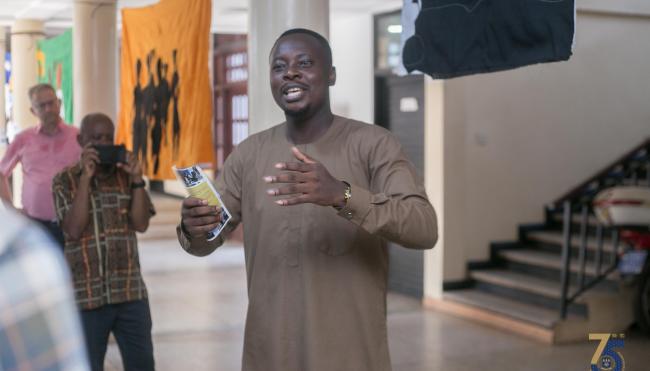MIASA Exhibition Showcases Textile Artworks by Artist-in-Residence

In collaboration with the Merian Institute for Advanced Studies in Africa (MIASA), an exhibition featuring the artistic works of Mr. Seyram Agbleze took place at the Kwame Nkrumah Complex at the Institute of African Studies.
The exhibition, titled "Still Here," showcased the works of Seyram Agbleze, a Ghanaian artist who employs woven textiles and collages to convey narratives about Africa and various subjects. He is also an Artist-in-Residence with the Institute.
Welcoming attendees to the exhibition, Dr. Grace Diabah, Director for MIASA, Ghana, highlighted the uniqueness of the event. She said, “this marks the Institute's first-ever art exhibition, a departure from their usual fellowship activities.”
She reiterated MIASA's interest in art as a means of academic exchange and noted that artworks and art lovers could interact and mutually enrich one another.
The Director for MIASA, Germany, Dr. Susan Baller, who also delivered brief remarks at the event, explained that “Seyram Agbleze collaborates with traditional leaders in Ho, working closely with them to incorporate woven backgrounds into his collage creations.” She highlighted the influence of Asafo flags in inspiring his innovative storytelling through woven textile flags.
“The central themes of Mr. Agbleze's flags revolved around youthfulness and harmony, reflecting contemporary governance challenges in Africa and the role of youth as agents of change.” Dr. Baller mentioned.
Mr. Seyram Agbleze, the exhibitor who spoke briefly before taking visitors around to tour the artworks on exhibition, expressed gratitude for the opportunity to collaborate with MIASA. He noted that “such partnerships offer us artists broader platforms to showcase our work.” He provided a detailed tour of the nine vibrant textile flags on display, explaining their artistic meanings, origins, and socio-political interpretations.
In a post-exhibition interview, Mr. Seyram Agbleze revealed that “my motivation for these artworks stemmed from my desire to celebrate West Africa's rich textile tradition. This stems from my experiences during a fellowship in the United Kingdom, which allowed me to tour various West African countries, where I witnessed diverse textile traditions that I consider valuable cultural heritage.”
Mr. Agbleze laid emphasis on the importance of textile traditions as a genuine way to convey the African narrative. He highlighted that textiles have a significant role in safeguarding and advancing African culture.
He also went down memory lane to share his artistic evolution, explaining that “I initially began as a painter but later incorporated textile traditions to enhance my storytelling abilities.”
On the future of his work, Mr. Agbleze outlined his intention to collaborate with other organisations and galleries to expand the reach of his artworks, underscoring the importance of promoting authentic African stories.
He called on European institutions to support African artists who aim to tell genuine African narratives, rather than relying solely on Western narratives. Agbleze stressed the critical role of the arts in shaping culture, calling to mind its significance in nation-building.
The nine flags on display were titled: "Wise King," "Mother is Home," "Migrants at Sea," "Migrators," "1957 Freedom," "Dahomey Amazons," "Sleeping Giant Africa," "Adinkra Crocodiles," and "Sankofa Reflections."
As part of the exhibition, a documentary focused on socio-economic issues such as governance, unemployment, illegal migration, and the legacy of slavery's impact on Africa's economic growth produced by Mr. Agbleze was screened. The documentary also explored how European educational institutions and agencies can contribute to Africa's development.
The exhibition was attended by Prof. Samuel Ntewusu, Director of the Institute of African Studies, along with staff, students, and members of the media.